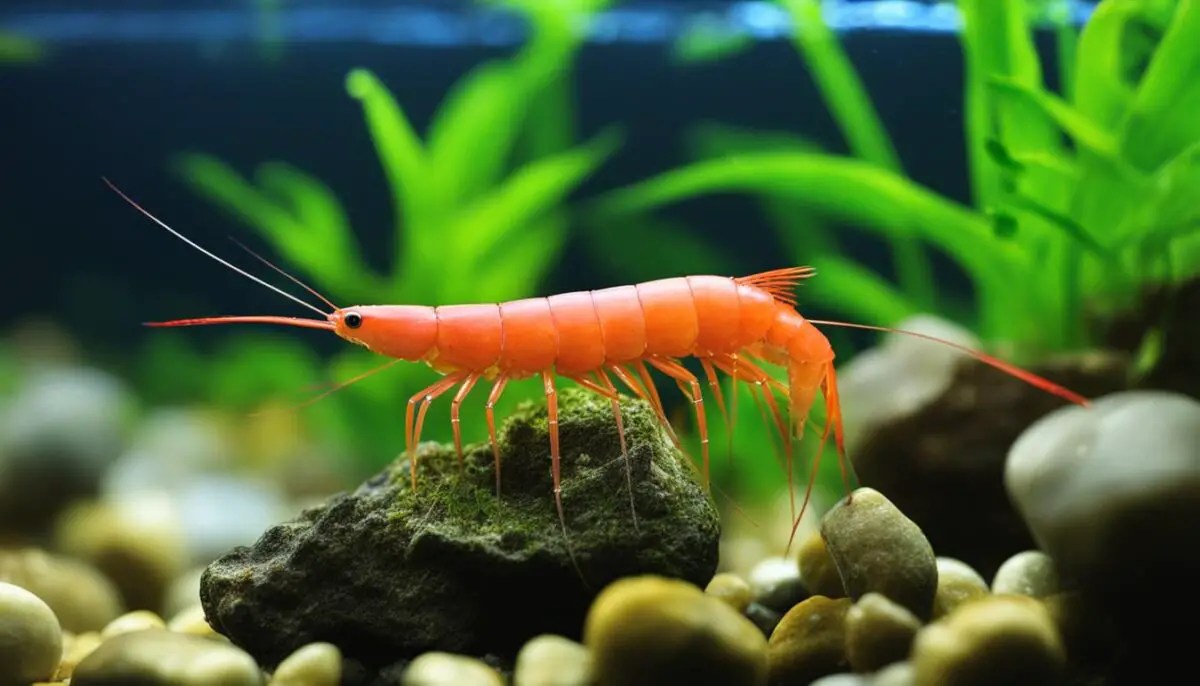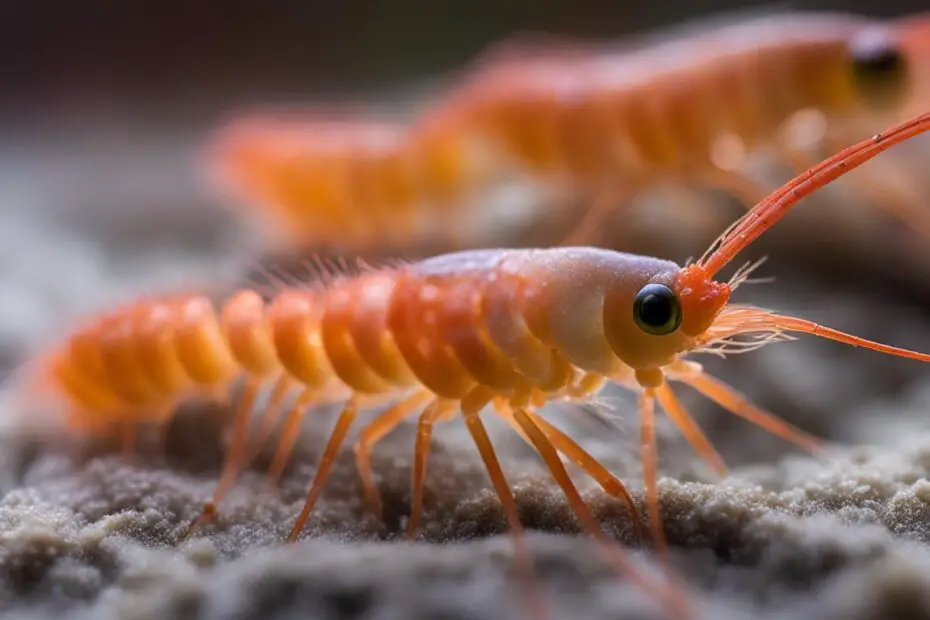Shrimp are fascinating creatures that have captured the interest of researchers and marine enthusiasts alike. With their vibrant colors and intricate behavior, they never fail to intrigue. One particular aspect that sparks curiosity is their reproduction. Many people wonder, “Do shrimp lay eggs?” Let’s delve into the world of shrimp reproduction, unveil the facts, and shed light on the process of shrimp oviposition.
Key Takeaways:
- Shrimp of the genus Lysmata exhibit an intriguing reproductive mode called protandric simultaneous hermaphroditism.
- Lysmata ankeri, a specific species of shrimp, is being studied to gain insights into its reproductive cycle and embryonic development.
- Shrimp eggs are fertilized internally and attached to the pleopod of the female, where they incubate before hatching.
- Various factors, such as water quality, temperature, and food supply, play a vital role in the shrimp breeding process.
- Understanding the process of shrimp egg laying and incubation is crucial for successful shrimp breeding efforts.
The Reproductive Cycle of Lysmata ankeri
In this study, specimens of L. ankeri were collected and observed over multiple breeding cycles. The pairs of L. ankeri analyzed in the study exhibited successive spawning, with the hermaphrodite (H) either mating with a genuine male (M) or another hermaphrodite (H). After molting, the pairs synchronized their molting cycles. The females laid eggs and the observation of successive spawning events was recorded. Mating behavior and egg development were closely monitored throughout the reproductive cycle.
| Observed Behaviors | Reproductive Cycle Stage |
|---|---|
| Hermaphrodite (H) mating | Mating initiation |
| Fertilization by a genuine male (M) or another hermaphrodite (H) | Egg fertilization |
| Molting synchronization of pairs | Post-molting phase |
| Egg laying by females | Egg production |
| Successive spawning events | Spawning period |
| Closely monitored mating behavior and egg development | Throughout the reproductive cycle |

Larval Development and Growth
Upon hatching, the shrimp larvae embark on a complex journey of growth and development. They go through multiple larval stages, gradually transforming in form and structure before reaching the adult stage.
The larval development of different Lysmata species has been extensively studied, offering valuable insights into the breeding habits and reproductive behavior of Lysmata shrimp. These studies have provided a deeper understanding of the developmental milestones and environmental factors that influence shrimp larval development.
Throughout their developmental journey, shrimp larvae undergo various physiological and morphological changes, allowing them to adapt to their changing surroundings and eventually thrive as adult shrimp.
Intricacies of Shrimp Larval Development
“The remarkable metamorphosis from shrimp egg to larva symbolizes the resilience and adaptability of these fascinating creatures. Understanding the intricacies of shrimp larval development is crucial for creating optimal breeding and rearing conditions. It sheds light on the delicate balance of factors necessary for successful shrimp reproduction and conservation.”
As we unravel the mysteries of shrimp reproduction, the process of egg incubation and hatching emerges as a vital chapter in the intriguing life cycle of these remarkable creatures. From internal fertilization and egg attachment to the gradual development of the embryos and the mesmerizing hatching event, every step in the process contributes to the perpetuation of shrimp populations and their diverse ecosystems.
Factors Affecting Shrimp Breeding and Reproduction
Successful shrimp breeding and reproduction require careful consideration of various factors to maintain a suitable environment. Understanding the impact of these factors is crucial for maximizing breeding success and ensuring healthy shrimp populations.
Water Parameters
The optimal pH range for successful shrimp reproduction is between 6.5 and 8.0. Maintaining stable water pH levels within this range is essential to support the shrimp’s reproductive behavior and egg development. Additionally, the water temperature should be maintained between 70 and 80 degrees Fahrenheit to create an ideal breeding environment.
Food Supply
Adequate food supply is crucial for successful shrimp reproduction. Shrimp require a balanced diet that includes high-quality commercial shrimp feed or a combination of natural and artificial food sources. However, it is important to avoid overfeeding, as excessive food can lead to water contamination, which can negatively impact shrimp health and reproductive abilities.
Water Quality
Water quality plays a significant role in shrimp breeding and reproduction. The presence of nitrite and ammonia in the water can be harmful to shrimp and inhibit their reproductive abilities. It is important to regularly monitor water parameters and ensure proper filtration and aeration to maintain optimal conditions. Regular water changes and the addition of live plants can also help maintain good water quality and create a suitable environment for shrimp breeding.
Additional Factors
Other factors that may affect shrimp breeding and reproduction include the availability of hiding places and suitable substrate for egg attachment, as well as the presence of predators or aggressive tank mates that can disrupt reproductive behavior. Providing appropriate hiding spots and choosing compatible tank mates can help reduce stress and promote successful shrimp breeding.
By carefully considering these factors and creating an optimal environment, shrimp breeders can increase the chances of successful breeding and maintain healthy shrimp populations.

Understanding Shrimp Egg Laying and Incubation
Shrimp are fascinating creatures when it comes to reproduction. They lay eggs, which are collected and attached to the female’s abdomen until they hatch. The process of shrimp egg laying and incubation involves various reproductive behaviors and physiological changes in the female shrimp.
First, the eggs are fertilized internally by the male shrimp. This internal fertilization ensures the eggs are ready for incubation and development. The shape and color of shrimp eggs can vary depending on the species. Fertilized eggs are typically oval-shaped and range in color from bluish-green to pale yellow.
The eggs are held together by a filament and are attached to the pleopod of the female. The pleopods are small swimming appendages located on the ventral side of the shrimp’s abdomen. This attachment secures the eggs in place and provides them with the necessary support and protection during incubation.
During the incubation period, the female shrimp takes great care of the eggs. She ensures they receive sufficient oxygen and nutrients for proper development. The incubation period can vary depending on environmental factors such as temperature and water conditions.
The process of shrimp egg laying and incubation showcases the remarkable adaptations and behaviors of these crustaceans. By attaching the eggs to their abdomen and ensuring their well-being during incubation, shrimp demonstrate their commitment to the survival of their offspring.
Once the incubation period is complete, the eggs hatch, releasing tiny shrimp larvae into the water. These larvae undergo a complex developmental process before reaching the adult stage. The larval stage is crucial for the growth and maturation of the shrimp, and it plays a significant role in their overall life cycle.
Understanding the process of shrimp egg laying and incubation is not only fascinating but also essential for successful shrimp breeding efforts. By studying these reproductive behaviors, scientists and aquarists can develop strategies to optimize shrimp breeding conditions and promote the healthy development of shrimp larvae.
| Key Points | Summary |
|---|---|
| 1. Shrimp lay eggs that are collected and attached to the female’s abdomen until they hatch. | The female shrimp serves as a nurturing chamber, providing the necessary support for egg development. |
| 2. The eggs are fertilized internally by the male shrimp. | Internal fertilization ensures the readiness of the eggs for incubation and development. |
| 3. The eggs are attached to the pleopod of the female shrimp. | The pleopods secure the eggs in place and provide support and protection during incubation. |
| 4. The incubation period varies depending on environmental factors. | Temperature and water conditions influence the duration of the incubation period. |
| 5. After incubation, the eggs hatch, releasing shrimp larvae. | The larvae undergo a developmental process before reaching the adult stage. |
Conclusion
In conclusion, the reproductive strategies of shrimp, such as the Lysmata ankeri species, demonstrate the fascinating phenomenon of protandric simultaneous hermaphroditism. This unique reproductive cycle involves successive spawning events and synchronized molting cycles, highlighting the intricate nature of shrimp reproduction.
Shrimp eggs, an integral part of this reproductive process, undergo an incubation period before hatching. During this period, the eggs develop and transform into larvae, which play a critical role in the growth and development of shrimp from eggs to adult individuals.
Various factors, including water quality, temperature, and food supply, significantly impact shrimp breeding and reproductive success. Maintaining optimal pH levels and water temperature within the recommended range, between 6.5 and 8.0 and 70 to 80 degrees Fahrenheit respectively, is crucial for successful shrimp breeding. Additionally, providing an adequate food supply while ensuring proper water quality management is essential for creating a suitable environment for shrimp reproduction.
Understanding the process of shrimp egg laying and incubation is vital for successfully breeding shrimp, as it allows for the implementation of appropriate breeding practices and the creation of optimal breeding conditions. By considering the diverse reproductive strategies and the various factors influencing shrimp breeding, shrimp enthusiasts and aquarists enhance their knowledge and make informed decisions to promote successful shrimp reproduction.
FAQ
Do shrimp lay eggs?
Yes, shrimp lay eggs. The eggs are attached to the pleopod of the female shrimp until they hatch.
What is the reproductive cycle of Lysmata ankeri?
The reproductive cycle of Lysmata ankeri involves successive spawning events and synchronized molting cycles.
How are shrimp eggs incubated and hatched?
Shrimp eggs undergo an incubation period before hatching. The larvae then undergo a developmental process before reaching the adult stage.
What factors affect shrimp breeding and reproduction?
Factors such as water quality, temperature, and food supply can influence shrimp breeding and reproductive success.
How do shrimp lay and incubate their eggs?
Shrimp eggs are fertilized internally by male shrimp and are attached to the pleopod of the female. They undergo an incubation period before hatching.
What are some conclusions about shrimp eggs and reproduction?
Understanding the process of shrimp egg laying and incubation is essential for successful shrimp breeding efforts.

